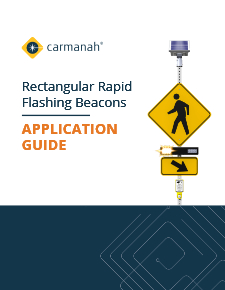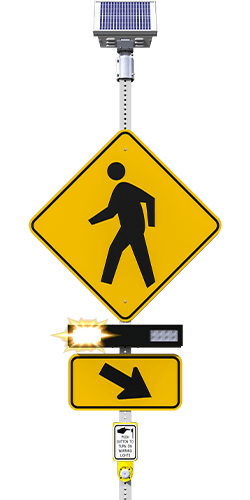MX SeriesTM
Rectangular Rapid Flashing Beacon (RRFB)
Increase visibility and reduce pedestrian crashes at crosswalks up to 47% with trusted, MUTCD-compliant technology.
Safe and frequent crossings are a key feature of walkable, livable communities—and not just at signalized intersections. Midblock crosswalks and marked crosswalks at roundabouts and other unsignalized locations can provide numerous safety benefits to pedestrians.
The inclusion of RRFBs in the MUTCD 11th Edition (2023), is an exciting step forward for road safety regulations.
The best way to optimize visibility and safety at these crossings is with Carmanah’s MX Series rectangular rapid flashing beacon (RRFB), the R920-MX RRFB
Crosswalks + connectivity:
R920-MX RRFBs
Our newest MX Series RRFBs take the already impressive capabilities of our best-selling R920 RRFBs and dials them up a notch—or two.
Here’s what you get with an MX RRFB:
- 3 years of free remote connectivity
- Actionable email and text alerts
- Remote system access via MX Cloud™
- Quick setup and local access with MX Field App™
- ‘Smart module’ design for simple installation and richer data
- Solar Power Report (SPR) prepared for every location
- Options for overhead lighting and accessible push buttons

Meets MUTCD Standards

Buy America / BABA compliant

3-year system warranty

Every MX system ships with 3 years free remote connectivity.
With MX, connectivity isn’t an add-on. We’ve embedded it into the hardware so that it automatically connects and reports to the cloud (and a free local app) the moment it receives power.
RECOMMENDED
MX Lite
Get actionable alerts and a network-wide view of your systems.
3 Years Free | $79/year at year 4
Features (Core)
- Out-of-the-box connectivity
- System alerts (email/text)
- Remote asset management with GPS map view and more
MX Plus
Make changes to your system settings and access data from anywhere.
$99/year
All MX Lite features and
- Remote programming
- Knockdown alerts
- Data Charting
- …and more
MX Pro
Create, edit and set schedules in bulk and on-the-fly.
$249/year
All MX Plus features and
- Remote scheduling
- 5-year historical data
- Export functionality
- …and more
How and where to use an RRFB
RRFBs are one of the best and easiest ways to increase walkability in a community without significant infrastructure changes. Explore our free RRFB Application Guide to design the layout of your RRFBs in multiple road scenarios and learn where they are best used.

RRFBs are a widely-used and highly effective treatment
RRFBs’ amber color and erratic flash pattern are proven to capture drivers’ attention, increasing yield rates by up to 98% and reducing crashes up to 47%, according to the FHWA. They meet MUTCD Standards and are a Proven Safety Countermeasure promoted by the Safe Transportation for Every Pedestrian (STEP) initiative.

Common crosswalk problems and RRFB solutions
These effective crosswalk countermeasures are reliable solutions to persistent issues in crosswalk visibility, driver yield rates, maintenance needs and more.
Problem
- Low yield rates at existing crosswalk.
- Low-intensity beacons are hard to see, especially during the day.
- Drivers are used to flashing beacons, so they no longer grab attention.
- Signal techs are reliant on the public to call in downed or damaged infrastructure.
- Engineers have limited insight into the adoption and/or effectiveness of their systems.
Solution
- RRFBs get drivers to yield up to 96% of the time.
- RRFBs use directional, high-intensity LEDs that are visible at all hours (SAE Standard J595 – Class 1).
- The erratic wig-wag + simultaneous flash pattern of the RRFB attracts driver attention.
- MX RRFBs alert personnel as soon as there’s an issue, be it a knockdown, low battery, or something else.
- MX Cloud provides easy access to data like pedestrian counts that can be used to assess effectiveness and make decisions about future infrastructure.


Proving RRFBs work
A 2010 FHWA-sponsored study in St. Petersburg, Florida, examined several midblock crosswalks using RRFBs. The results from one test site:
- Yield rate before the installation: 8.6%
- Yield rate after the RRFB installation: 92%
Based on average prices for other crosswalk solutions, the RRFB is the most effective crosswalk solution, with the highest yield rate per dollar spent on the system.
A community toolkit for creating safer crossings
In support of citizens, local groups, and elected officials advocating for safer local roadways, we’ve compiled a step-by-step Crosswalk Safety Guide and toolkit. It’s our hope this guide makes the crucial work of pedestrian safety a little less confusing and a little easier to implement.
Additional Resources for RRFBs
Article
An Overview of the Most Effective Crosswalk Treatments – Weighing your options for an unsignalized crossing? Here’s a roundup of your treatment options and how they compare.
Data Sheet
Download our R920-MX Data Sheet – Get an overview of the features and benefits of the R920-MX, plus all the tech specs and product options—all in a single, shareable document.
Case Study
Nevada High School Boosts Safety with New RRFB Crosswalk – Learn how a Carmanah system in Reno is helping increase yield rates and improve safety for students, staff, and parents.
Video
Building Crosswalks for Walkable Communities – See how cities across North America are using RRFBs to improve pedestrian safety and build complete streets for all road users.
Application Guide
RRFB Application Guide – Download this visual guide for the most common RRFB placements and installations at marked, uncontrolled mid-block crosswalks.
Article
An Overview of the Most Effective Crosswalk Treatments – Weighing your options for an unsignalized crossing? Here’s a roundup of your treatment options and how they compare.
Data Sheet
Download our R920-MX Data Sheet – Get an overview of the features and benefits of the R920-MX, plus all the tech specs and product options—all in a single, shareable document.
Case Study
Nevada High School Boosts Safety with New RRFB Crosswalk – Learn how a Carmanah system in Reno is helping increase yield rates and improve safety for students, staff, and parents.
Carmanah’s RRFB product portfolio
Explore our RRFB product portfolio solutions designed to improve pedestrian safety, visibility and crosswalk efficiency in any setting.
R920-MX
Connected, solar or AC-powered, crosswalk flashing beacons and signs.

R920-E (Gen 3)
Compact, 15w solar-powered rectangular rapid flashing beacon (RRFB) for crosswalks.

R920-F (Gen 3)
Bright, 30w solar-powered rectangular rapid flashing beacon (RRFB) for busy crosswalks.

SC315-G (Gen 3)
Solar/AC-powered rectangular rapid flashing beacon (RRFB) for shaded/busy crosswalks.

R920-MX
Connected, solar or AC-powered, crosswalk flashing beacons and signs.

R920-E (Gen 3)
Compact, 15w solar-powered rectangular rapid flashing beacon (RRFB) for crosswalks.

R920-F (Gen 3)
Bright, 30w solar-powered rectangular rapid flashing beacon (RRFB) for busy crosswalks.

SC315-G (Gen 3)
Solar/AC-powered rectangular rapid flashing beacon (RRFB) for shaded/busy crosswalks.

Get in touch
Have questions or need assistance? Connect with sales for product inquiries and quotes, support for technical issues, or visit the product support center for self-service resources.